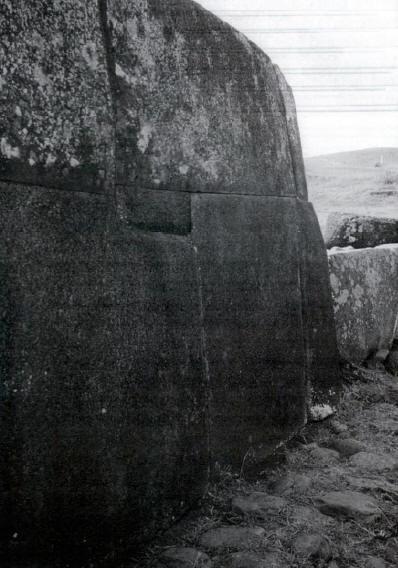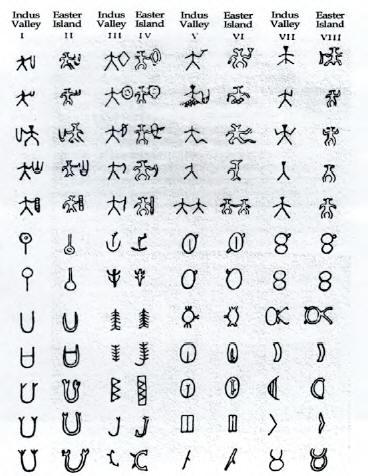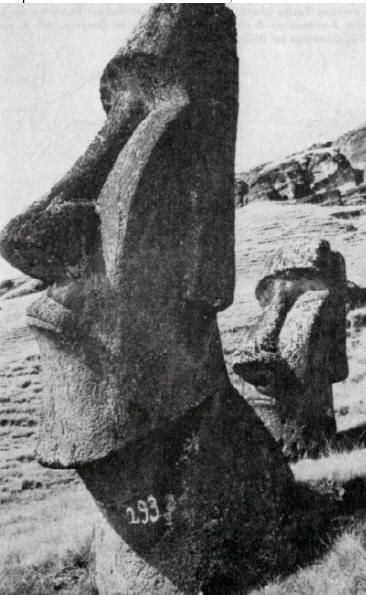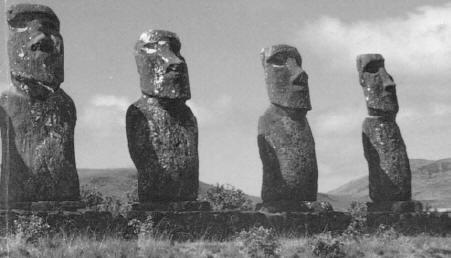Grid of the Gods (30 page)
Authors: Joseph P. Farrell,Scott D. de Hart

Stone Wall at Easter Island
61

Irregular Stone Cuts at Easter Island
62
Witkowski points out that there are four distinctive features of the constructions of these walls on Easter Island that tie them directly to the walls of Sacsayhuaman, Tiahuanaco, and even the high Andean “Incan” fortress of Machu Picchu:
1. The stone blocks are very closely matched to each other, despite rounded, complex shapes;
2. They are polygonal;
3. Their external surfaces are convex; and,
4. The entire wall is inclined toward the center of the construction.
63
All this evidences at least
some
sort of contact between these far-flung locales in historical times.
64
Before looking at the script that ties Easter Island to the other side of the Pacific, it is worth mentioning that in 1956 the famous explorer and archaeo-navigator Thor Heyerdahl discovered a statue on Easter Island wholly unlike its more famous moai “Face” statues, in that this one was a bearded man closely resembling in style similar statues found at Mohenjo Daro in India. Two similar specimens were discovered in Bolivia near Tiahuanaco. This is the first beginning of some “cracks” in the “land bridge” theory that the Native American populations migrated across the Bering Strait thousands of years ago, for what these connections suggest is rather a migration across the South Pacific.
65
The most telling evidence for such a connection, however, is the aforementioned script of Easter Island, the Rongo Rongo writing.

Rongo Rongo Script of Easter Island
66
Witkowski notes that his fellow countryman, the linguist Professor Benon Z. Szalek of the University of Szczecin, made a detailed study and comparison of the Rongo Rongo script with the writing of the Indus Valley civilization in India, the civilization centered around the mysterious ruins of Mohenjo Daro:

Comparison of Rongo Rongo Script to that of the Indus Valley
67
Compounding the difficulty that this astonishing resemblance represents is the fact that the Indus Valley-Mohenjo Daro civilization disappeared ca. 1000–1200 years BC according to conventional archaeology.
It means that at the moment when Easter Island was inhabited, Mohenjo Daro’s unique system of writing, its religion, etc.… lived only in human memory. It (had) been gone for over two millennia (at least according to officially accepted theories)! It was simply one of the three oldest civilizations on our planet, along with the Sumerians and the empire of the Pharaohs. Could Easter Island’s culture reach that deep into the prehistory of mankind? Incidentally, these circumstances make the Rongo Rongo script the oldest system of writing in use in historical times, for no less than four thousand years.… In the case of this chain of traces, the truth seems so obscure, and so strange at the same time, that one has to ask himself a question: what really happened there, in the Pacific and Indian Ocean, all those thousands of years ago?
68
As we shall see in a moment, that question becomes even more peculiar when one examines the ruins of Mohenjo Daro themselves, for they afford yet another connection with distant Tiahuanaco and Viracocha, and a very bizarre one at that.
Contributing to this mystery is the fact that Easter Island’s own indigenous peoples are of apparent Polynesian descent, but their local legends tell of an earlier race of a “long eared” people with “taller skulls, brighter skin, and of course a very different cultural heritage. They spoke a non-Polynesian language and according to the known tradition, it was they and only they, who knew the secret of writing.”
69
These “long-ears” were, according to local tradition, white skinned and red haired!
70
This tradition was confirmed by the first permanent European settler on the island, the French priest Eugene Eyraud, who began a campaign of burning the wooden tablets containing the Rongo Rongo script. Eyraud observed that the local natives were not able to read the writing, confirming the idea that the
“long-ears” kept the secret of reading the writing to themselves.
71
According to the islanders’ traditions, “the first king, Hotu Matua, brought with him 67 most precious tablets from their land of origin in the west.”
72
This tradition is very suggestive, for it indicates not only that the Easter Islanders maintained that they came to the Island “from the West,” i.e., across the Pacific, but that part of the purpose may have been to bring priceless records of some sort to the island, and perhaps from thence, elsewhere. In any case, this tradition is also suggestive of another possible connection to the West, and to the celebrated Sumerian “Tablets of Destinies,” the terrible objects of power with which and over which the “gods” fought a tremendous war, upon the conclusion of which, some were destroyed and others were taken “elsewhere.”
73
If bringing some priceless records
was
the purpose of the migration to Easter Island, then there is a sort of logic to it, if the purpose was to prevent such records from falling into the wrong hands by hiding them in a remote place, for one cannot get much more remote than Easter Island.
That there
was
some sort of hidden purpose behind the migration to this remote and desolate place is evident from the fact that the semi-triangular island itself covers only about 45 square miles, and from the fact that its hard igneous rock contains little soil suitable for agriculture. Yet, the island contains several distinctive and famous statues of heads — the famous Maoi — weighing as little as 10 or as much as 200 tons,
74
all of which are facing the center of the island in order, according to local legend, to protect the island from sinking into the sea as had happened a previous time in the population’s legends.
75
All this, of course, has prompted the question of how such
a small population in such an isolated place could have quarried and then transported such enormous and finely-carved statues.

Maoi Heads on Easter Island

Maoi Heads on Easter Island
Local legend and tradition does not help much in answering this question, for on Easter Island, just as at various ancient sites on the Grid in Great Britain, the tradition states that the stones moved themselves!
There is, however, a clue as to the means of this movement in local tradition, but that clue opens up yet another mysterious connection between Easter Island and, of all places, Egypt:
…(According) to the legend the stony giants moved “on their own,” to designated places thanks to the magical power called “mana.” regardless of whether it’s true or not, it is, however, nonetheless a fact that the same type of description of motive power emerges in the “second best” place of archaeological mystery in the Pacific, namely Nan Madol — some 10,000 km away to the west (around 6200 miles)…
However this is by no means the end of the puzzling parallels. The mana power was symbolized by a sign that perhaps was supposed to concentrate is, and which was carved out on the backs of some statues. Strangely enough, it bears a striking similarity to
the Egyptian magic “ankh” cross, which was supposed to perform the same function.
76
Nor is the presence of the strange “ankh-like” symbol the only connection to the distant cultures of the Middle East.
The idea of “bird-men” figured prominently into the cultus of Easter Island and its traditions.
77
This chimerical concept even appears as a heiroglyph in the Rongo Rongo script itself.
78
This bird- man symbol was perhaps the hieroglyph for the islanders’ chief god, Make Make, who lived in the sky and who had such a command over the mysterious “mana” force that he was isolated, because his power over the mana was dangerous.
79
Make Make’s dangerous control or use of the mana force was manifest in lightning, “exactly the same motif associated with the main Andean god, Viracocha,”
80
and, for that matter, the similar association of the principle god of Greece — Zeus — with thunderbolts, and the Mesopotamian gods Ninurta and Nergal with the same thing.
81
Moreover, there are other strange connections of the “bird-men” gods to the Middle East. One need only think of the depiction of the Egyptian god of science and wisdom, Thoth:
